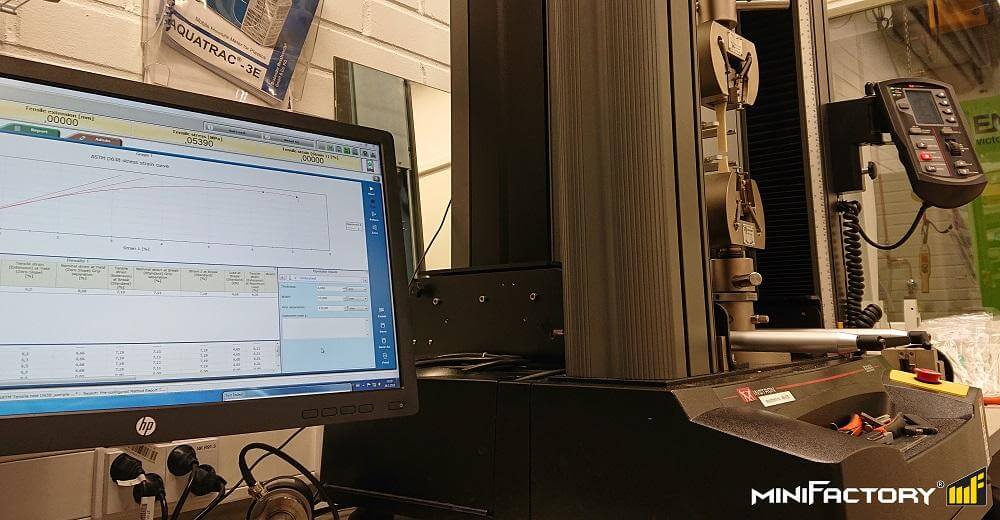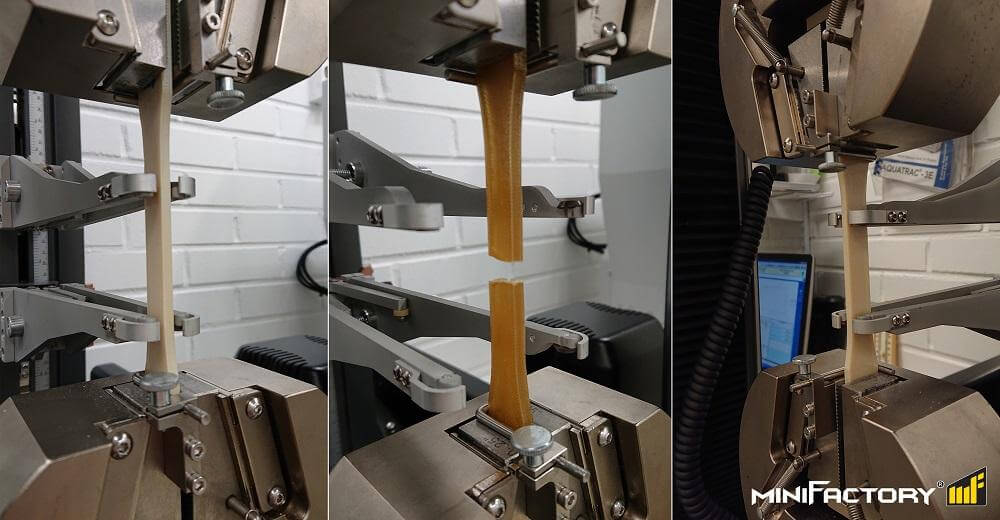The datasheets consist of reliable information about the characteristics of 3D printed parts made with miniFactory Ultra 3D printer. The first batch of technical datasheets describe the mechanical characteristics of ULTEM® AM1010F and ULTEM® AM9085F by SABIC and PEKK-A made by Kimya 3D materials by ARMOR which is based on Kepstan® by Arkema. miniFactory will continue validating new materials for the next datasheets.
Ultra-Polymer 3D printing has increased the interest among those who have used high-performance polymers in their daily basis. With these relatively expensive materials, the 3D printing offers cost-effective manufacturing method for the end-use parts. Therefore, the main target of the industry is to use the 3D printed parts in the end-use applications. For now, the lack of knowledge about the mechanical properties of the material when 3D printed has been the biggest challenge. This has been preventing the end-use application manufacturing with 3D printing.
The reason why miniFactory is providing technical datasheets based on 3D printed parts instead of the injection moulding datasheets is following. When a part is created by using FFF technology, the mechanical characteristics of the part varies depending on the printing orientation. In layer by layer manufacturing, the z-axis has lower mechanical strength compare to other axes. Currently the datasheets on the market are providing information about injection moulded parts, which is not comparable to 3D printed parts. This is due to the differences in the manufacturing processes.
The 3D printing industry has let the process itself with too less attention. To be able to take the industry to next level from prototypes to real life applications, the printing process needs to be in the spotlight of the attention. For the design engineer it is crucial to have correct technical datasheet for each manufacturing method.

To be able to trust on the 3D printed part to be used in real life applications, it is crucial to know the mechanical properties of the print. This can be done only with repeatable process which is known. To achieve the demanded repeatability, the process needs to be stable. In order to achieve desired results in everyday use, the process needs to meet the validated parameters. These parameters are based on using a specific validated printer, optimized printing profiles and validated materials. By following the process, the customer can achieve the mechanical properties shown in the technical datasheets. By changing any of these three parameters, the process changes and the printed part might not match the technical datasheet.
For example, PLA is known to be an easy polymer to print. This is based on the demands that the material has for the printer. The most important requirement for PLA is to have stable enough extruder temperature. Printing with ultra-polymers is on a completely different level of manufacturing. The printing process needs to be optimized for the demanding requirements of the ultra-polymers. With the miniFactory Ultra, the process of printing ultra-polymers is designed to be as easy as printing PLA on a standard printer. This is made possible with the heated chamber (up to 250°C), mechanical accuracy and the validated printing process. This combination is being supported by the technical datasheets, which point out the mechanical characteristics of the print.

The technical datasheets provide information about different ASTM standard tests. The announced datasheets are a result of a long process of material validation. The validation of a material is a part of the process that miniFactory is offering for the customers. These tests have been completed with standardized testing equipment following ASTM standard guidelines. All the parts used in the tests were printed with a certificated and fully traceable materials and using miniFactory’s validated printing profiles. The same printing profiles are provided for our customers to ensure the desired printing results. For these material datasheets, we validated three different materials: Sabic ULTEM® AM1010F filament, Sabic ULTEM® AM9085F filament, PEKK-A made by Kimya 3D materials by ARMOR which is based on Kepstan® by Arkema.
The validation process from the first test prints to the finalized datasheets took almost one year of dedicated work of our specialists. Multiple different test batches and precise adjustments of the printing profiles to find the desired setup for the demanded properties and surface quality. The validated materials chosen for this datasheet announcement provide full traceability. This allows for a precise inspection of the mechanical properties of the print. With the full traceability, the path from the filament manufacturer to a final product can be pointed out. miniFactory will continue validating new materials with the same passion to create industry level prints with demanded repeatability.
Contact us for the complete datasheets.
The results of our first material datasheets will be showcased in the Rapid.Tech + FabCon 3.D, June 25-27. 2019 at Erfurt, Germany. Come and meet us at our stand 2-124
ULTEM® is a registered trademark of SABIC or its subsidiaries or affiliates
Kepstan® is a registered trademark of Arkema France
"*" indicates required fields